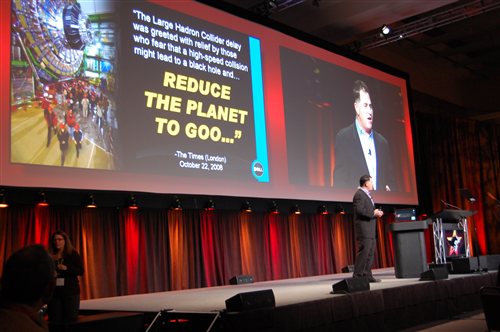 Michael Dell this morning addressed attendees of the SC08 conference and spoke of the ‘fourth wave’ of supercomputing where powerful HPC-based clusters will be used by organizations of all sizes to solve complex compute problems.
Michael Dell this morning addressed attendees of the SC08 conference and spoke of the ‘fourth wave’ of supercomputing where powerful HPC-based clusters will be used by organizations of all sizes to solve complex compute problems.
SC08 is taking place in Dell’s backyard in Austin, Texas, and Dell is taking the opportunity to show the gathering of some of the world’s most prestigious scientists, engineers, programmers, researches and educators Dell’s engineering prowess when it comes to high performance computing.
In his keynote, Michael spoke of how supercomputing was previously reserved only for those who could afford it – a trait traceable back to the beginning of supercomputing. In the 1970s, the first wave of supercomputing was dominated by specialized processors and proprietary operating systems. The second wave in the 80s and 90s was more focused on advancements in microprocessor-based systems. The third wave showed an increase in the percentage of HPC clusters in the Top 500 list. And finally, we’re now entering a new period of high-performance computing that’s defined by further standardization across the HPC ecosystem. This “fourth wave” will make powerful HPC clusters accessible for the first time to more organizations, large and small, worldwide.
Here’s what Dell announced during SC08:
— Dell, Intel and Lawrence Livermore National Labs (LLNL) jointly announced the availability of LLNL’s Hyperion cluster for use by the HPC community.
— The Texas Advanced Computing Center’s (TACC) Dell Stallion virtualization cluster will be the largest in the world comprising 45 Dell 30-inch flat panel monitors (307 million pixels) powered by Dell XPS desktop gaming systems.
— Michael also discussed the new NVIDIA GPU that will soon be available in Dell Precision workstations.
Dell had numerous HPCC demonstrations during the show in its large booth and had a number of speakers that presented papers on a variety of topics. The show runs through Thursday of this week.
I had the opportunity to sit down with Dr. Reza Rooholamini from Dell’s Clustering and Solutions Group about the latest trends in supercomputing. I’ve known Reza since I first joined the company in 1999, when Dell was first beginning its foray into the high performance clustering business. Back then, x86-based systems were a rarity on the Top500 list and our presence started with just a 64-node cluster at the Cornell Center for Advanced Computing. Each node on that system had a quad Pentium 3 Xeon that ran at 500Mhz running Windows NT.
Today, the Top500 list features more than 400 x86-based systems and we are seeing the same peak performance that was previously only possible on a supercomputer now available on a mobile workstation.
Let’s hear what Reza has to say about the state of high performance computing.